While the flutter of a butterfly delights, the quiet presence of a moth in your home should raise concern. You might overlook a single moth, but when holes appear in your favourite wool sweater or grains clump mysteriously in the pantry, it’s time to pay attention. Recognizing a moth infestation isn’t always straightforward, but with a keen eye, you can identify the tell-tale signs before damage escalates. Are those tiny white larvae just innocent bystanders, or the harbingers of a larger problem? Understanding these subtle indicators is essential—so let’s explore what you need to watch for.
Key Takeaways
– Look for irregular holes and webbing in fabrics, indicating larval feeding.
– Check for powdery frass near natural fibres, a sign of moth larvae activity.
– Inspect food items for webbing, larvae, or clumped grains, indicating pantry moths.
– Notice adult moth sightings, especially in high numbers, suggesting an infestation.
– Use pheromone traps to detect moth population levels in affected areas.
Common Signs of Moth Activity
When tackling a moth infestation, understanding the common signs of moth activity is vital. Moths undergo a moth life cycle comprising four stages: egg, larva, pupa, and adult. Observing these stages can help you pinpoint an infestation.
Larvae, often mistaken for small worms, are voracious feeders, leaving irregular holes in fabric and webbing in stored food. Adult moths, although less destructive, serve as indicators of breeding sites. Their presence in high numbers suggests significant larval activity nearby.
To conduct a thorough analysis, inspect areas with potential moth harborages, such as closets and pantries. Note any frass, which is the powdery waste left by feeding larvae. This is especially visible in areas where they consume natural fibres or grains.
Additionally, you might observe discarded pupal casings, signalling the change to adult moths, and further confirming active cycles.
Implementing prevention methods is vital to mitigate further damage. Regular cleaning and maintaining low humidity levels disrupt the moth life cycle. A vacuum cleaner can remove larvae and eggs that are often nestled in crevices.
Additionally, sealing food in airtight containers and using pheromone traps can effectively reduce moth numbers and prevent future infestations.
Identifying Moth Species
Recognizing the signs of moth activity is just the beginning; identifying the specific moth species involved is equally important for targeted management. To accurately determine the moth species, observe the moth behaviour and physical characteristics. Pay attention to wing patterns and colours, as these are often indicative of particular species. For instance, the common clothes moth (Tineola bisselliella) has buff-coloured wings, whereas the pantry-invading Indian meal moth (Plodia interpunctella) boasts reddish-brown wingtips.
Understanding the lifecycle stages is essential in your identification process. Moths undergo complete metamorphosis, including egg, larva, pupa, and adult stages. Different species may show variations in these stages, such as the duration of larval development or pupation locations.
By examining the larvae, which often cause the most damage, you can identify species-specific traits. For example, clothes moth larvae tend to feed on natural fibres, leaving behind silk webbing.
Documenting these observations with photographs or notes can assist in later consultations with entomologists or pest control professionals. Precise identification allows for more effective control strategies tailored to the species’ unique habits and vulnerabilities, ensuring a thorough approach to managing your moth infestation.
Inspecting Wardrobes and Closets
A thorough examination of wardrobes and closets is essential in detecting moth infestations, as these are common areas where moths target fabrics and clothing.
Begin by evaluating the wardrobe materials; moths frequently infest natural fibres like wool, silk, or cotton. Synthetic fabrics are less susceptible, so focus primarily on natural textiles. Confirm you inspect the entire garment, paying close attention to seams, folds, and hidden areas, as these are preferred nesting sites for moth larvae.
Next, consider your closet organisation. A cluttered space provides moths with ample hiding spots. Methodically remove and inspect each item, maintaining observational precision. Look for telltale signs such as small holes in fabrics, webbing, or the presence of larvae and adult moths. Use a flashlight to illuminate dark corners and crevices.
Observe the condition of the wardrobe materials themselves. Discoloration or unusual textures may indicate larvae activity. The presence of fine, powdery dust is often a result of larvae feeding on fibres.
Checking Pantry and Kitchen
In the vigilance against moth infestations, the pantry and kitchen demand your keen attention, as they harbour food sources that attract these pests. Conduct a thorough pantry inspection to identify signs of activity.
Examine all food containers, especially those holding grains, nuts, and dried fruits. Look for webbing or larvae, often found in corners or seams of packaging. The presence of adult moths, which may appear as small, fluttering insects, is a critical indicator.
Focus on kitchen cleanliness to reduce potential moth habitats. Regularly clean shelves, and guarantee that any food spills or crumbs are promptly attended to. Moths are known to exploit even the smallest food residues.
Pay particular attention to cracks and crevices, which can harbour eggs or larvae. Inspect under appliances and inside cabinets, where debris can accumulate unnoticed.
Evaluate the condition of food storage containers. Airtight, sealed containers are essential in preventing moth access. Replace any compromised packaging, such as torn bags or loosely fitting lids, to minimise infestation risk.
Steps to Confirm Infestation
After meticulously inspecting your pantry and kitchen, it’s important to confirm any suspicions of a moth infestation through systematic observation.
Begin by closely monitoring moth behaviour during twilight hours, since moths are primarily nocturnal. Use a flashlight to scrutinise pantry crevices—focus on the corners, where larvae flourish. Look for the presence of webbing or clumped grains, which are indicative of larval feeding habits. A handheld magnifier might assist in detecting minute eggs or larvae, enhancing your observational precision.
Record the frequency and location of adult moth sightings. The repeated emergence of moths from specific pantry areas suggests an infestation epicentre. Note any irregular patterns in food packaging, such as holes, which signify moth entry points.
Implementing pheromone traps is a critical step in confirming infestation. These traps attract male moths, aiding in population assessment. If the trap captures numerous moths, infestation is probable.
Frequently Asked Questions
Can Moth Infestations Affect My Pets or Indoor Plants?
Moth infestations, through their feeding behaviour, generally target fabrics rather than pets or plants. For pet safety, guarantee no ingestible moth products are accessible. Observational precision in mouth behaviour around plants helps mitigate potential indirect effects.
Are There Any Natural Remedies to Prevent Moth Infestations?
Ah, the noble quest of outsmarting moths! Try herbal repellents like lavender sachets or cedar blocks. Essential oils such as peppermint provide a fragrant yet scientifically questionable shield. Observe results with precision, as moths often scoff at your natural defences.
How Long Does It Take for a Moth Infestation to Develop?
You’ll notice a moth infestation within 4-6 weeks, aligning with their life cycle. Observe infestation signs like larvae or webbing on clothes and food. Precise monitoring helps you identify these subtle changes in your environment quickly.
Do Moths Prefer Certain Fabrics Over Others?
In your modern-day moth adventure, you’ll notice their behaviour shows a clear preference for wool, silk, and cashmere. These fabric types provide essential nutrients, explaining why moths prioritise them over synthetic materials. Their choice is evolutionary precision.
Can Moth Infestations Occur in Cars or Other Vehicles?
Yes, moth infestations can occur in vehicles. Look for infestation signs like larvae or cocoons in fabric seats and carpets. Vehicle prevention involves regular cleaning, vacuuming, and using repellents to deter moths from establishing a breeding ground.
Conclusion
So, you’re now equipped to spot a moth infestation with the precision of a 19th-century detective. By inspecting your wardrobe and pantry for telltale signs—like irregular holes, webbing, and larvae—you’ll uncover these sneaky culprits in their favourite haunts. Use pheromone traps to assess their numbers and confirm your suspicions. Remember, consistent sightings and damaged items are your red flags. Act swiftly, and your home will be moth-free in no time. Good luck, sleuth!




